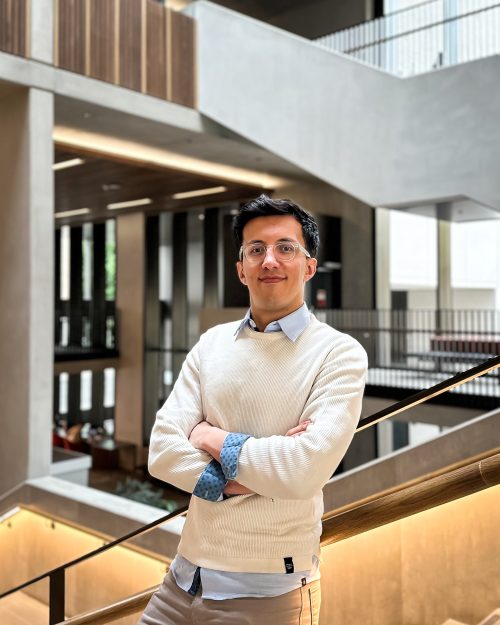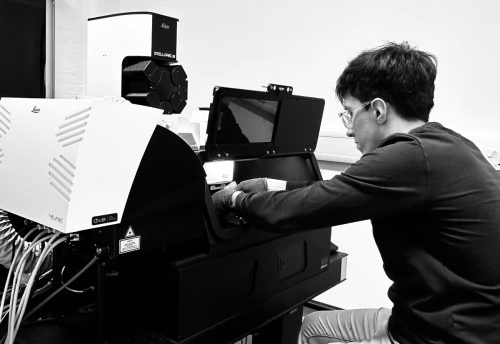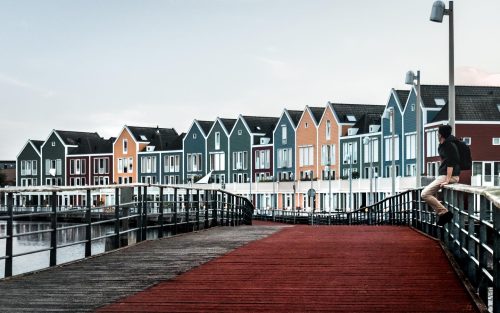An interview with 2024 BSDB Beddington Medal winner Delan Alasaadi
Posted by the Node, on 19 June 2024
We recently caught up with Delan Alasaadi, who received the 2024 British Society for Developmental Biology (BSDB) Beddington Medal for the best PhD thesis in developmental biology defended in the year previous to the award. Delan gave a talk about his PhD work at the joint BSDB/ Genetics Society Spring Meeting in Warwick in April 2024, and was presented with the Beddington Medal.

Where were you born, and where did you grow up?
I started school in Baghdad, Iraq, where I was born, and continued my studies in Amman, Jordan. My next academic adventure was in Lebanon, where I did my undergraduate degree at the American University of Beirut (AUB).
When did you first become interested in science?
I first became interested in science during my early teenage years. My curiosity about the world around me was growing by the day, and I was constantly puzzled about a wide range of questions like: Where do ideas come from? How can we stimulate more? And how can we decide which notions to follow and which to let go of? Too many questions that involve too many fields like psychology, sociology, science, and more. The underlying theme, regardless of the topic, was this passion for questioning and the attempt to find answers, which became a driving force in my life beyond my “working” hours. The word working is highlighted because if you have an interest in exploring what is around you, beyond your Petri dish or animal model, then do you ever stop?
One direct influence on this way of thinking was the movie “A Beautiful Mind,” which I watched when I was about 15 years old. Avoiding spoiling this marvel of a movie, it initially had a grip on me for eliciting how appealing the outcome of being a scientist was. As I continued my education, this blend of curiosity and inspiration from stories like Nash’s (the main character) drove me to explore various fields of science. Certainly, years later, my view of the movie’s ending changed, and I came to the realization of the importance of grit in the pursuit of what is meaningful knowledge over what is expedient despite obstacles. This mindset has stayed with me, fuelling my continuous quest for knowledge and my love for science.
How did you come to do a PhD with Roberto Mayor at University College London (UCL)?
My undergraduate degree was in biomedical sciences, and my master’s degree at the University of Chester was in differentiation and de-differentiation of macrophages. Despite enjoying doing both, I constantly was asking How (in what) I would develop a niche? And What does that question really constitute? It is easier, saying to myself, to start in a new or emerging field because there is a lot to discover – no matter what, I’ll make it. I was completely wrong, yet the outcome of this approach worked great. That thinking made me choose to explore how physical forces influence the biological behavior of cells. With that interest, the city, and the diverse expertise and pivotal discoveries in mind, I applied to Roberto’s lab. Roberto and his team, throughout decades, specialized in untangling the physical microenvironment and cell signaling pathways that dictate the induction, migration, and differentiation of neural crest cells. The lab has access to a wide range of animal models, cell lines, and biophysical tools, which meant the only limitation was the questions I would ask. I was stunned in my first meeting with Roberto, where we had a well-rounded, simple, down to earth conversation about the possibility of me joining his team. The freedom to express ideas freely and discuss them constructively is a predisposition to any place I aim to be in – so I joined. One week into my PhD, Roberto taught my first fundamental lesson; he said: “The frog is the boss; we will ask the frog if our question is right or wrong.” I knew I was in the right place to get it done.
Your recent NCB paper summarises your main PhD project on neural crest competence. How did the project get started?
This project started when I was around ten years old. One of Roberto Mayor’s students was investigating the resilience of neural crest cells in a Petri dish. The student put a small glass (coverslip) on top of these cells, and to their surprise, the neural crest cells did not die, yet they did not retain their identity either. Although this was a fascinating result, the cause behind this outcome remained unclear – it got shelved. Two decades later, I joined Roberto’s lab and decided to revisit this phenomenon. The immediate hypothesis was that the coverslip applied pressure to the neural crest cells (a mechanical stimulus), changing their nature and preventing them from retaining their neural crest identity—so many questions to answer and so many avenues we could have taken. One question came right at the top of the list: Does this happen in vivo as well? If so, How does that actually happen? Given that neural crest cells in developing embryos are exposed to hydrostatic pressure generated from a liquid-filled cavity (blastocoel cavity), I explored hydrostatic pressure’s role on neural crest cells, an emerging mechanical stimulus in the field of biophysics.
The work involved a wide range of techniques – do you have a favourite?
It has to be inflation and deflation. These two techniques involved artificially changing the hydrostatic pressure within the blastocoel cavity by changing its volume. We called aspirating fluid from the blastocoel Deflation and adding fluid Inflation. Although these two assays were a challenge to optimize from scratch to suit our model of choice, the Xenopus embryos, I enjoyed them the most, at the end of the day, it felt like inflating or deflating a balloon – it is OK, arguably a must, to stay in touch with your inner child-like exploratory mode.
Were there any frustrating moments?
Sure! I wonder if there is anyone who embarked on a scientific journey without being utterly and completely frustrated. However, throughout my PhD, I approached these challenging moments with a more unbiased mindset and as objective as possible I can be. In these moments, your choice of the “right” environment is vital – you get to pick the premise of what “right” means here. Thus, I often mention it is important to pick an environment where you can build a story out of the things that have worked, but it is even more important to be in a place where it is ok when things are not going well too, and you can find means of support through these time(s)!

In your medal award talk at the BSDB meeting, you mentioned your collaborative visit to the Netherlands was supported by a travelling fellowship from The Company of Biologists. Can you talk more about your experience of the visit?
In the interview for my PhD, a panellist said: “Congratulations on this step, but do not forget to get out of the lab.” I did not appreciate its significance till I had the chance to collaborate with the Hiiragi group in Utrecht, Netherlands. Indeed, as I mentioned, we were exploring the possibility of hydrostatic pressure’s role on neural crest cells. We needed to measure directly the change (if any) in Blastocoel’s hydrostatic pressure during gastrulation. During my stay, I had the privilege of meeting new people, where we discussed the struggles and triumphs we went through during our PhDs and the current limitations in our understanding of biological systems. Prof. Takashi Hiiragi and Dr. Moghe Prachiti’s expertise and advice throughout this collaboration were crucial for the successful outcome we achieved in this approach. This collaboration would not have been possible without the generous funds from The Company of Biologists. I highly recommend that, if you are reading this, you find your question, apply for funds, and explore beyond what is known – how exciting. Indeed, the science that we conduct at our benches builds our careers, but the science we do in collaboration builds scientific character.
What other project(s) did you work on during your PhD?
It is an exhilarating feeling to see your colleagues’ projects evolve and to have the chance to contribute with a suggestion, idea, or even a figure. I joined my colleague as a co-first author to investigate the role of RanBP1 on neural crest migration and its role in front-rear polarity. After neural crest induction (the focus of my main story), migration of these cells begins a widely studied phenomenon that has been previously linked to different signaling pathways (e.g., Wnt pathway). However, this work explored the possibility of a new player (RanBP1) in regulating this phenomenon by controlling cellular processes such as cell polarity.
Further, I have written a review of the most recent finding on the role of biomechanical cues on cell fate during early development. In this summary, we explore the latest in vitro, ex vivo, and in vivo studies on how mechanical cues interlink with biochemical signaling to promote tissue-specific fate and function of various cells. I found it is necessary to step out from my main work from time to time and come back with a refreshed mindset to tackle the next set of challenges.
If you took one abiding memory with you from your PhD, what would it be?
This is definitely a hard question to answer. There are so many different memories that led to this moment. Indeed, memories like surviving a global pandemic, walking in empty streets of central London, having the entire London tube for myself, the chance to go to the Netherlands, numerous conversations and mentorship from mentors and friends, and so many countless other memories. Simply, I cannot be dishonest to all of these career and character-building experiences by selecting just one!
What have you been working on since you completed your PhD? What’s next for you?
Neil deGrasse Tyson, world-renowned astrophysicist, said, “Ignorance is the natural state of mind for a research scientist … the boundary between what is known and unknown in the universe.” (Astrophysics for People in a Hurry; p32-33). In that boundary is where I aim to be. To this end, I joined the Acton Lab as a postdoctoral fellow, aiming to bridge the gap between our understanding of normal developmental processes and the transition into a pathogenic state. Generally, my interest remains the same: How do cells make their decisions? Can we influence that process for the betterment of our future?
What techniques or areas in developmental biology excite you the most lately?
Arguably, molecular biology spawned from developmental biology, and now we live in an era overwhelmed by the vast amount of information generated daily by this field. This invokes a paralyzing feeling of “Where do we go from here…?” Thus, I am not generally excited about particular techniques; however, I am quite interested in ideas. Indeed, I am very keen to see how developmental biology will piece together the intricate and detailed information we have of a certain cellular behavior to a much wider picture of understanding biological systems. “Chase ideas and not techniques, Delan!” was the second fundamental lesson I learned from Roberto Mayor during my first year as a PhD.
Outside of the lab, what do you like to do?
I did my PhD in London, so there is always something happening and to do! My general interests are photography, tennis, climbing, and swimming. However, my favourite remains a cup of joe and a conversation. So, If you are in town, let’s go for one?!

Follow Delan on X/ Twitter
Reference
Alasaadi DN, Mayor R. Mechanically guided cell fate determination in early development. Cell Mol Life Sci. 2024 May 30;81(1):242. doi: 10.1007/s00018-024-05272-6. PMID: 38811420; PMCID: PMC11136904.
Alasaadi DN, Alvizi L, Hartmann J, Stillman N, Moghe P, Hiiragi T, Mayor R. Competence for neural crest induction is controlled by hydrostatic pressure through Yap. Nat Cell Biol. 2024 Apr;26(4):530-541. doi: 10.1038/s41556-024-01378-y. Epub 2024 Mar 18. PMID: 38499770; PMCID: PMC11021196.
Barriga EH, Alasaadi DN, Mencarelli C, Mayor R, Pichaud F. RanBP1 plays an essential role in directed migration of neural crest cells during development. Dev Biol. 2022 Dec;492:79-86. doi: 10.1016/j.ydbio.2022.09.010. Epub 2022 Oct 4. PMID: 36206829.


 (1 votes)
(1 votes)